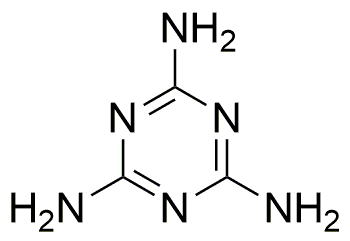Melamine monomer is widely utilized in research focused on:
- Resin Production: It is a key ingredient in the manufacture of melamine-formaldehyde resins, which are used in laminates, adhesives, and coatings. These resins are known for their durability and resistance to heat and chemicals, making them ideal for kitchen countertops and flooring.
- Plastics Industry: Melamine monomer is employed to produce high-quality plastics that are used in household items, such as dinnerware and decorative objects. Its ability to withstand high temperatures makes it a preferred choice over other plastic materials.
- Textile Industry: It is used as a finishing agent in textiles to enhance wrinkle resistance and durability. This application is particularly beneficial for clothing that requires easy care and longevity.
- Fire Retardants: Melamine monomer is incorporated into formulations for fire-resistant materials. Its properties help in reducing flammability, making it valuable in construction materials and safety equipment.
- Fertilizers: In agriculture, it is used in the production of slow-release fertilizers, which provide a steady supply of nitrogen to plants. This application supports sustainable farming practices by reducing the frequency of fertilizer application.
General Information
Properties
Safety and Regulations
Applications
Melamine monomer is widely utilized in research focused on:
- Resin Production: It is a key ingredient in the manufacture of melamine-formaldehyde resins, which are used in laminates, adhesives, and coatings. These resins are known for their durability and resistance to heat and chemicals, making them ideal for kitchen countertops and flooring.
- Plastics Industry: Melamine monomer is employed to produce high-quality plastics that are used in household items, such as dinnerware and decorative objects. Its ability to withstand high temperatures makes it a preferred choice over other plastic materials.
- Textile Industry: It is used as a finishing agent in textiles to enhance wrinkle resistance and durability. This application is particularly beneficial for clothing that requires easy care and longevity.
- Fire Retardants: Melamine monomer is incorporated into formulations for fire-resistant materials. Its properties help in reducing flammability, making it valuable in construction materials and safety equipment.
- Fertilizers: In agriculture, it is used in the production of slow-release fertilizers, which provide a steady supply of nitrogen to plants. This application supports sustainable farming practices by reducing the frequency of fertilizer application.
Documents
Safety Data Sheets (SDS)
The SDS provides comprehensive safety information on handling, storage, and disposal of the product.
Product Specification (PS)
The PS provides a comprehensive breakdown of the product’s properties, including chemical composition, physical state, purity, and storage requirements. It also details acceptable quality ranges and the product's intended applications.
Certificates of Analysis (COA)
Search for Certificates of Analysis (COA) by entering the products Lot Number. Lot and Batch Numbers can be found on a product’s label following the words ‘Lot’ or ‘Batch’.
*Catalog Number
*Lot Number
Certificates Of Origin (COO)
This COO confirms the country where the product was manufactured, and also details the materials and components used in it and whether it is derived from natural, synthetic, or other specific sources. This certificate may be required for customs, trade, and regulatory compliance.
*Catalog Number
*Lot Number
Safety Data Sheets (SDS)
The SDS provides comprehensive safety information on handling, storage, and disposal of the product.
DownloadProduct Specification (PS)
The PS provides a comprehensive breakdown of the product’s properties, including chemical composition, physical state, purity, and storage requirements. It also details acceptable quality ranges and the product's intended applications.
DownloadCertificates of Analysis (COA)
Search for Certificates of Analysis (COA) by entering the products Lot Number. Lot and Batch Numbers can be found on a product’s label following the words ‘Lot’ or ‘Batch’.
*Catalog Number
*Lot Number
Certificates Of Origin (COO)
This COO confirms the country where the product was manufactured, and also details the materials and components used in it and whether it is derived from natural, synthetic, or other specific sources. This certificate may be required for customs, trade, and regulatory compliance.


